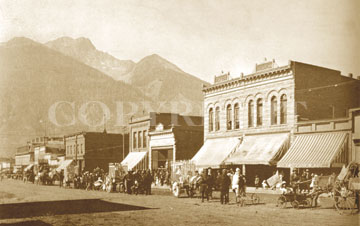| Silverton Magazine - Silverton, Colorado | ||
| Downtown Silverton | Burke's Custom Tours for Photographers & Artists | Silverton Magazine home page |
|
All content © San Juan Publishing Group, Inc, All rights reserved. SILVERTON IS A NATIONAL HISTORIC LANDMARK. There are fewer than 2,500 in the United States and only twenty in Colorado. Silverton is considered one of the most intact historic towns in America. The main street, Greene Street, is named after George Greene, an early pioneer and city father. Mr. Greene brought the first smelter equipment into Baker's Park in 1874 and was instrumental in Silverton's development.  The Greene Street Landmark District is comprised of many elegant
buildings. (See the Historic Walking Tour, pages 9-11 for detailed
descriptions.) Most of them were built between 1882 and 1910, largely
during Silverton’s two early boom times. Silver ruled between 1882 and
1893 and miners flooded into the region, hoping to strike it rich.
Tents, log cabins, and wooden structures popped up all over town and
the surrounding mountainsides. Before long, as the town and the mines
prospered, many of these structures were replaced by more permanent
buildings. The arrival of the railroad in 1882 made it easier to haul
in supplies and haul out ore for processing in Durango. The town
blossomed.
The Greene Street Landmark District is comprised of many elegant
buildings. (See the Historic Walking Tour, pages 9-11 for detailed
descriptions.) Most of them were built between 1882 and 1910, largely
during Silverton’s two early boom times. Silver ruled between 1882 and
1893 and miners flooded into the region, hoping to strike it rich.
Tents, log cabins, and wooden structures popped up all over town and
the surrounding mountainsides. Before long, as the town and the mines
prospered, many of these structures were replaced by more permanent
buildings. The arrival of the railroad in 1882 made it easier to haul
in supplies and haul out ore for processing in Durango. The town
blossomed.
Then, in 1893, the United States chose not to use silver any longer as the basis for its currency, resulting in the "Silver Panic." The value of silver plummeted, sounding a death knell to old-time subsistence mining. About that same time, however, electricity became available for mining. Its first use was in nearby Telluride, powered by the Ames Power Plant. Use of electricity meant less labor-intensive, more cost effective mining and the ability to go after the harder-to-reach ores. Gold was the new goal and, with the help of new technology, more easily extractable. As mining changed, so did Silverton, which continued to grow and become more established as a substantial town.  The local chapter of the Western Federation of Miners built the Miner’s
Union Hall in 1901. Home to various labor organizations, it was also
the center of a bitter strike against mine owners in 1929. Union
leaders met here, and after a fight, were escorted out of town for
their own safety. The union was officially broken that day.
The local chapter of the Western Federation of Miners built the Miner’s
Union Hall in 1901. Home to various labor organizations, it was also
the center of a bitter strike against mine owners in 1929. Union
leaders met here, and after a fight, were escorted out of town for
their own safety. The union was officially broken that day.
Across the street, Ye Old Livery was once a working livery run by the Silverton Transfer Company. Built in 1897, it featured an elevator to the second floor... The Grand Imperial Hotel was built in 1882. Its beautiful, ornate gingerbread makes it one of Silverton's flagship buildings. The hand-carved rosewood bar with its diamond-dusted mirror (brought by ship from England) is still in place. At the opposite end of the block, the Posey and Wingate building, built in 1880, is the oldest commercial building in western Colorado and has been a hardware store, a bank, and a pool and billiards hall. Directly across the street is the Benson Block, built in 1901. The corner space was occupied by the County Club, a saloon that had one of the most expensive bar fixtures ever imported to Silverton. The pink building next to it was the Exchange Livery, originally two stories high. Buggies and wagons were housed downstairs and horses upstairs. Next door, the Teller House, erected in 1896 by brewer Charles Fischer, housed two saloons — the Frog for the French and the Tyrol for the Italians. Silverton Town Hall, with its silver bell tower, was erected in 1907. Fire almost completely destroyed it in 1991, but it was restored with painstaking care and won the National Honor Award from the National Trust for Historic Preservation in 1996. At the north end of Greene is the San Juan County Courthouse, built in 1907 for $79,000! It is still a working courthouse and has magnificent courtrooms on the second floor. Photographs Photographic images courtesy of San Juan Historical Society. All rights reserved. Top right: Silverton, 1893. Ore wagons line up on Greene Street. Notice the wooden storefronts. Bottom: Silverton, July 4, 1915. The wooden buildings have been replaced by susbstantial buildings, may of which still stand today. The Billy Cole building is in the foreground. (See walking tour for details.) Grand Imperial Hotel is just visible in the distance. |
|||||
| advertising |
| The Silverton Magazine. Copyright 2000-2010 Published by San Juan Publishing Group, Inc., Colorado No part of this publication may be reproduced in any means whatsoever without written authorization from SJPG. (Plagerizers will be hung from the yardarm and fed to the mountain sharks!) Queries for re-print rights, email [email protected] |
Copyright San Juan Publishing Group, Inc. Web design by Kathryn R Burke
